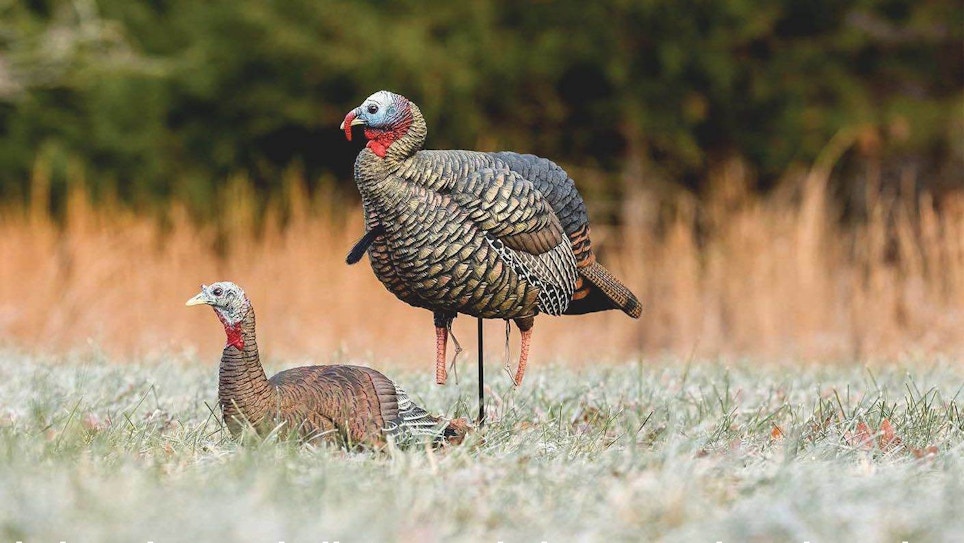
Understanding turkey behavior will help you choose a successful turkey decoy setup. (Photo courtesy of Avian-X Decoys)
Do turkey decoys really work? Fred Zink from Port Clinton, Ohio, says they do.
Zink has bowhunted turkeys on and off for the past 32 years. He’s the founder of Avian-X decoys and Zink calls, and is also the media director for Plano Synergy, the company that manufactures, designs and develops Avian-X decoys. He said modern turkey decoys are really impressive, effective and realistic, which can help lure a bird within bow range and hold its attention long enough to get an ethical shot. Now he carries and uses decoys 100% of the time he pursues turkeys.
Learn how to select a decoy and get Zink’s decoy setup tips and recommendations.
Selecting Decoys
Before heading afield, determine which decoys to use. Consider the phase (early, middle or late) of the season you’re hunting and what turkey you’re after, because subordinate gobblers and dominant gobblers can react differently to different styles and poses of decoys. Knowing the intricate details of how turkeys interact and behave throughout the season will also help you pick a realistic, suitable decoy setup.
Early-season strategy: Use multiple hen decoys and a single tom or jake in a quarter- or half-strut position.
When hunting from a pop-up blind, you can carry in several decoys, including a male, a lookout hen and a few feeding hens. Set them up in a small area a few feet away from each other. Zink said this gives bowhunters in a blind an advantage because the decoy flock looks realistic for the time of year.
Using a tom or jake in a quarter- or half-strut position will also attract a dominant gobbler looking to show your decoy who’s boss.

Late-season strategy: Use a breeding-style hen decoy and a jake.
A breeding hen decoy is basically a turkey sitting on the ground as it would sit on a nest. Zink likes to put out one of these decoys and then position a jake 5 to 6 feet behind the hen like he’s going to breed her.
“A jake decoy, nine out of 10 times, will be more effective because you’re able to attract almost every male turkey in the woods,” Zink said. A full-strut tom decoy, meanwhile, is great for dominant gobblers, but it can intimidate subordinate birds in the middle or at the bottom of the pecking order.
Decoying Tips
- Pay attention to orientation. Zink said the direction you face your male turkey decoy is important. A decoy that faces away from the direction another turkey would come from shows it’s subdominant. A decoy that faces toward an opposing turkey shows it’s dominant – or thinks it is – and ready to fight. Position the head of a tom decoy toward the direction you think a turkey will come from. If you’re using a jake, face the head away.
- Position decoys 10 yards from your blind. Use the decoys as a landmark. Set them up at 10 yards so you know when the bird is within bow range.
- Make the setup as realistic and natural as possible. Turkeys get wise to decoy setups as the season progresses, so you must use lifelike decoys and organize them in convincing setups.
- Be patient. If turkeys are in the area, Zink says, it’s just a matter of time before one sees your decoy and heads your way. Hunters often get impatient while waiting and leave too soon. He’s arrowed many gobblers between 10 a.m. and 1 p.m., which is when most hunters leave their blind for lunch. Don’t miss your midday opportunity. Instead, pack a lunch and stick with it.

Be Safe
Always be careful when transporting turkey decoys. Carry them in a duffle bag or the cargo bag of your vest so they’re hidden from other hunters as you walk to your spot. If you can’t do that, wrap them in blaze orange when you’re on the move. When choosing an ambush location, be sure you can see if hunters approach from beyond the decoys. Avoid any situation where someone with a shotgun could fire at your decoys and be hidden from you.
Author’s note: Visit www.bowhuntersunited.com for more how-to bowhunting information.





